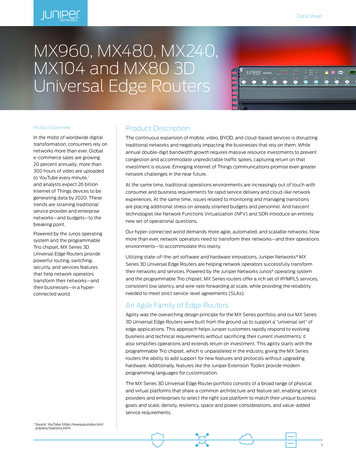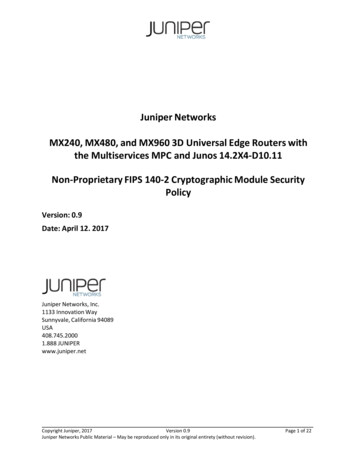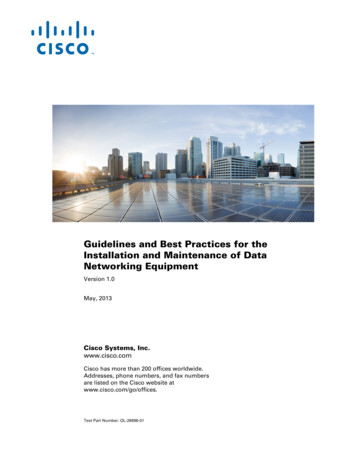
Transcription
Data SheetMX960, MX480, MX240,MX104 and MX80 3DUniversal Edge RoutersProduct OverviewProduct DescriptionIn the midst of worldwide digitalThe continuous expansion of mobile, video, BYOD, and cloud-based services is disruptingtransformation, consumers rely ontraditional networks and negatively impacting the businesses that rely on them. Whilenetworks more than ever. Globalannual double-digit bandwidth growth requires massive resource investments to prevente-commerce sales are growingcongestion and accommodate unpredictable traffic spikes, capturing return on that20 percent annually; more than300 hours of video are uploadedto YouTube every minute,1investment is elusive. Emerging Internet of Things communications promise even greaternetwork challenges in the near future.and analysts expect 26 billionAt the same time, traditional operations environments are increasingly out of touch withInternet of Things devices to beconsumer and business requirements for rapid service delivery and cloud-like networkgenerating data by 2020. Theseexperiences. At the same time, issues related to monitoring and managing transitionstrends are straining traditionalare placing additional stress on already strained budgets and personnel. And nascentservice provider and enterprisenetworks—and budgets—to thebreaking point.technologies like Network Functions Virtualization (NFV) and SDN introduce an entirelynew set of operational questions.Powered by the Junos operatingOur hyper-connected world demands more agile, automated, and scalable networks. Nowsystem and the programmablemore than ever, network operators need to transform their networks—and their operationsTrio chipset, MX Series 3Denvironments—to accommodate this reality.Universal Edge Routers providepowerful routing, switching,security, and services featuresthat help network operatorsUtilizing state-of-the-art software and hardware innovations, Juniper Networks MXSeries 3D Universal Edge Routers are helping network operators successfully transformtheir networks and services. Powered by the Juniper Networks Junos operating systemtransform their networks—andand the programmable Trio chipset, MX Series routers offer a rich set of IP/MPLS services,their businesses—in a hyper-consistent low latency, and wire-rate forwarding at scale, while providing the reliabilityconnected world.needed to meet strict service-level agreements (SLAs).An Agile Family of Edge RoutersAgility was the overarching design principle for the MX Series portfolio, and our MX Series3D Universal Edge Routers were built from the ground up to support a “universal set” ofedge applications. This approach helps Juniper customers rapidly respond to evolvingbusiness and technical requirements without sacrificing their current investments; italso simplifies operations and extends return on investment. This agility starts with theprogrammable Trio chipset, which is unparalleled in the industry, giving the MX Seriesrouters the ability to add support for new features and protocols without upgradinghardware. Additionally, features like the Juniper Extension Toolkit provide modernprogramming languages for customization.The MX Series 3D Universal Edge Router portfolio consists of a broad range of physicaland virtual platforms that share a common architecture and feature set, enabling serviceproviders and enterprises to select the right size platform to match their unique businessgoals and scale, density, resiliency, space and power considerations, and value-addedservice requirements.1Source: YouTube, https://www.youtube.com/yt/press/statistics.html1
MX960, MX480, MX240, MX104 and MX80 3D Universal Edge RoutersData Sheet The MX 2020 and MX2010 are ideal for large servicenetworks operating with different technologies—withprovider and cloud networks, cable applications, andsupport for Multiprotocol BGP (MBGP), dynamic tunnelsconverged edge and core architectures.using MPLSoGRE or Virtual Extensible LAN (VXLAN)encapsulation, virtual routing and forwarding (VRF) tables The MX960 is ideal for large service provider and cloudor E-VPNs, and NETCONF, along with the mechanismsnetworks, cable applications, and mobile service cores.required to send traffic between VRF and global routing The MX480 is ideal for midsize service provider, cloud/datatables based on configuration and policy.center, and cable applications, and enterprise cores. Data Center and Cloud Edge: MX Series routers are the The MX240 is ideal for smaller service provider and cablemost flexible data center/cloud edge routers in the industry,sites, data center interconnect, and enterprise WANs.with support for multiple overlay encapsulations, including The MX104 is a temperature-hardened, space-efficientVXLAN, Network Virtualization using Generic Routingrouter that is ideal for mobile aggregation and enterpriseEncapsulation (NVGRE), MPLSoUDP, MPLSoGRE, 802.1BR,WAN applications.SR-MPLS, and SR-V6. The MX5, MX10, MX40, and MX80 are space- and power- Enterprise WAN: Large enterprises and governmentefficient routers optimized for enterprise WAN, data centeragencies worldwide use MX Series routers to build theirinterconnect, branch aggregation, and campus applications.own overlay network over a service provider’s Layer 2 orThis agility is evident in the wide variety of MX Series use casesMPLS network, using encapsulation technologies such asthat have been proven in the world’s most demanding networks,MPLSoGRE, VXLAN, and IPsec for secure transport.including: Universal Metro/Aggregation: MX Series routers offer a fullsuite of routing and switching features, allowing network Business Edge: MX Series routers support the broadest rangeof L2/L2.5/L3 VPN services available today, in combinationoperators to choose a deployment model that best fitswith multilayer, multiprotocol reliability to ensure thattheir business and technical needs. These routers can becustomer SLAs are met under all network conditions.deployed as IP/IP VPN edge routers, Ethernet VPN (EVPN)and virtual private LAN service (VPLS) provider edge Internet/Peering Gateway: MX Series routers support the high(VPLS-PE) routers, MPLS label-switching (LSR) routers,performance, reliability, scale, and density needed to efficientlyand as Layer 2 Ethernet switches or Layer 3 IP routers.peer with Internet and other service provider networks. Mobile Backhaul: In addition to switching, routing, and Broadband Network Gateway (BNG): MX Series routerssecurity features, MX Series routers support highly scalableoffer the highest subscriber density and most sophisticatedand reliable hardware-based timing that meets thebroadband edge features, including hierarchical quality ofstrictest LTE requirements, including Synchronous Ethernetservice (HQoS) features, available in the industry.for frequency and the Precision Time Protocol (PTP) for Universal SDN Gateway: MX Series routers deliverfrequency and phase synchronization. In addition, the MX104a comprehensive solution for interconnecting virtualis ETSI 300-compliant for deployment in mobile applications.and physical networks—as well as between virtualAt-a-Glance MX Series 3D Universal Edge Routers ComparisonMX960MX480Rack units16Systems per rack3SlotsPer slot 242411 MPCs6 MPCs2 MPCs4 fixed10GbE slots 4 MICslots4 fixed 10GbE 32 MIC slots33 MIC slots2 fixed 10GbE 34 MIC slots35 MIC slots480 Gbps480 Gbps480 Gbps20 Gbps20 Gbps20 Gbps20 Gbps20 Gbps10.566 Tbps5.76 Tbps1.92 Tbps780 Gbps80 Gbps60 Gbps40 Gbps20 sYesYesYesNAMaximum 1GbE440240808080604020System throughputMaximum 10GbE440240808841NAMaximum 40GbE1327224NANANANANAMaximum 100GbE44248NANANANANA10GbE DWDM884816NANANANANA100GbE DWDM22124NANANANANAThe MX80 has two front MIC slots and one rear MIC slot. The rear MIC slot only supports the MS-MIC.3The MX40 has two front MIC slots and one rear MIC slot. The rear MIC slot only supports the MS-MIC.4The MX10 has two front MIC slots and one rear MIC slot. The rear MIC slot only supports the MS-MIC.5The MX5 has one front MIC slot and one rear MIC slot. The rear MIC slot only supports the MS-MIC.6Note, capacity shown is based on most commonly deployed redundant configuration.7Note, capacity shown is based on most commonly deployed redundant configuration.22
MX960, MX480, MX240, MX104 and MX80 3D Universal Edge RoutersData SheetArchitecture and Key ComponentsJunos OSThe MX960, MX480, and MX240 are modular chassis-based 3DJunos OS is a reliable, high-performance, modular networkrouters that share the following components:operating system that is supported across all of Juniper’s physical Modular Port Concentrators (MPCs) provide routing, MPLS,switching, inline services, subscriber management, andHQoS among many other features. MPCs may also hostinterfaces directly or via Modular Interface Cards (MICs) thatallow users to “mix and match” interface types. Powered bythe programmable Trio chipset, MPCs collect and streamtelemetry that identifies resource utilization, loss and delay,and other metrics.and virtual routing, switching, and security platforms. Junos OSimproves network operations and increases service availability,performance, and security with features like low-latency multicast,comprehensive QoS, unified in-service software upgrade (unifiedISSU), and Junos Continuity, which eliminates the risk andcomplexity of OS upgrades. With secure programming interfaces,the Juniper Extension Toolkit (JET), versatile scripting support, andintegration with popular orchestration frameworks, Junos OS offersflexible options for DevOps style management that can unlock Switch Control Boards (SCBs) feature an integratedmore value from the network.switch fabric that connects to all slots in the chassis ina nonblocking architecture. The SCBs house the RoutingNetwork Edge ServicesEngine, control power to MPCs, monitor and control systemMX Series routers can host optionally licensed Junos OS-basedfunctions such as fan speed and the system front panel,network edge services at scale, both inline on MPCs as welland manage clocking, resets, and boots.as on dedicated service cards. Hosting network edge services The Routing Engine (RE) provides the control plane, runsJunos OS, and handles all routing protocol processes aswell as the software processes that control MPCs, chassison MX Series routers reduces network cost and complexityby eliminating numerous elements, operating systems, andinterconnections.components, system management, and user access to the MPCs support inline services using the programmable Triorouter. REs communicate with MPCs via dedicated out-of-chipset; supported services include flow monitoring, 1:1band management channels.Network Address Translation (NAT), port mirroring, genericThe MX104 is a mobile, optimized, ETSI 300mm-compliantrouting encapsulation (GRE), IP tunneling, logical tunnels,chassis with high redundancy and 80 Gbps of throughput. Thelawful intercept, and video monitoring.MX104 offers up to four MIC slots and redundant fixed 10GbE The MS-MPC and the MS-MIC provide dedicated processinginterfaces for flexible network connectivity.for compute-intensive services such as carrier-grade NAT(CGNAT), IPsec, stateful firewall, deep packet inspection,The MX5, MX10, MX40, and MX80 are software upgradeableflow monitoring, and load-balancing.through 80 Gbps, enabling cost-effective “pay as you grow” scaleto meet evolving market requirements. These routers have up tofour MIC slots and two fixed 10GbE interfaces for connecting tothe network.MX Series Platform/Feature 80MX40MX10MX5Firewall filters/ACLs33333333DDoS—control plane33333333DDoS—FlowSpec33333333Stateless filters L2-L433333333Stateful services833333333GRE reassembly333333331:1 NAT933333333Flow monitoring1033333333Video monitoring1133333333Lawful intercept33333333Mirroring33333333Includes IPsec, SFW, CGN, DPI; requires an MS-MPC or MS-MIC8Provided by Junos Address Aware; requires an MS-MPC or MS-MIC9Provided by Junos Traffic Vision; requires an MS-MPC or MS-MIC10Provided by Junos Video Focus; supported on programmable Trio chipset113
MX960, MX480, MX240, MX104 and MX80 3D Universal Edge RoutersData SheetMX Series Platform/Feature Matrix (continued)Service X10MX5Deep packet 3333Traffic load balancing14333NoNoNoNoNoIPsec1533333333Stateful 33333333HTTP header manipulation17333NoNoNoNoNoRedundant RE3333NoNoNoNoUnified ISSU3333NoNoNoNoNonstop active routing(NSR)3333NoNoNoNoFast restoration33333333Operation, Administration,and Maintenance (OAM)33333333Enhanced SLA and queuing33333333Junos Fusion Edge (AD)33333333Logical systems33333NoNoNoVirtual router/switch33333NoNoNoPath Computation ElementProtocol (PCEP)33333333OpenConfig33333333YANG data modeling33333333Juniper Extension Toolkit33333333Provided by Junos Application Aware; requires an MS-MPC12Provided by J-Flow; can be hosted on the Routing Engine (RE), MPC (inline), or MS-MPC/MS-MIC13Provided by Junos Traffic Load Balancer; requires an MS-MPC/MS-MIC14Provided by Junos Site Secure; requires an MS-MPC/MS-MIC15Provided by Junos Network Secure; requires an MS-MPC/MS-MIC1617Provided by Junos Web Aware; requires an MS-MPC/MS-MICKey Features and BenefitsUnmatched Network AvailabilityMX Series routers ensure network and service availability witha broad set of multilayered physical, logical, and protocol-levelresiliency features, including Juniper’s Virtual Chassis technology,which supports chassis-level redundancy while enabling usersJunos Continuity and Unified In-Service SoftwareUpgrade (Unified ISSU)Junos Continuity and Unified ISSU features remove the downtimerisks associated with implementing new hardware or upgradingoperating systems. Junos Continuity eliminates OS upgrades and systemto manag
MX960 MX480 MX240 MX104 n MX80 3 niversa dg outers Data heet Architecture and Key Components The MX960, MX480, and MX240 are modular chassis-based 3D routers that











